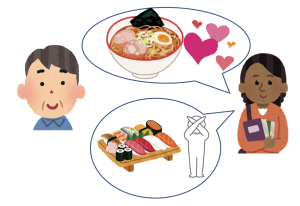Module 26.1 Dialogue
Title
Naomi Johnson’s host father asks what Johnson eats or does not eat to decide on a restaurant

| Language | Script and Translation |
Japanese |
|
Romanization |
1 Otousan: Ra-men o tabemasu ka?
2 Jonson: Ee, tabemasu. Daisuki desu. 3 Otousan: Sushi mo tabemasu ka? 4 Jonson: Iie, tabemasen. 5 Otousan: Sou desu ka. |
English translation |
1 Host father: Do you eat ramen?
2 Jonson: Yes, I do. I love it. 3 Host father: Do you eat sushi as well? 4 Jonson: No, I don’t. 5 Host father: I see. |
Vocabulary
More Useful Words
Grammar Notes
| Particle を (o) |
を is used to indicate the noun that proceeds it is a direct object of the verb in the sentence. For example,
| Japanese | 私はお酒を飲みます。 |
| Romanization | Watashi wa osake o nomimasu. |
| English | I drink sake. (or I will drink sake.) |
| Explanation | “Sake” is the direct object of the action of “drink” |
| Japanese | 私はテレビを見ます。 |
| Romanization | Watashi wa terebi o mimasu. |
| English | I watch TV. (or I will watch TV.) |
| Explanation | TV is the direct object of the action of “watch” |
Japanese is an SOV language, meaning the subject is followed by the object, and then the verb in that order. English, on the other hand, is an SVO language.
Japanese language (SOV)
| 私 | は | すし | を | 食べます |
| Watashi | wa | sushi | o | tabemasu |
| Subject: I | Particle:
Topic marker |
Object: sushi | Particle:
Object marker |
Verb: eat |
| S | O | V |
vs. English language (SVO)
| I | eat | sushi |
| subject | verb | object |
| S | V | O |
In English, we use “preposition” which is a word used before a noun to show direction, time, location, spatial relationships, or to introduce an object. Some examples of prepositions are words like “in,” “at,” “on,” “of,” and “to.” Source:
https://academicguides.waldenu.edu/writingcenter/grammar/prepositions
In Japanese, we call them “postpositions” which is a word used after a noun to show direction, time, or location. These postposition words are called “particles” or 助詞 (じょし) in Japanese.
For example,
I will go to Kyoto. “to” precedes the location Kyoto, thus a preposition
京都に行きます。”に (to)” follows the location, thus a postposition
| Japanese verb conjugation |
Watch this video (also embedded below) to learn about Japanese verb types and how to conjugate Japanese verbs from their casual forms to polite form:
You can also use the explanations below to learn how to conjugate Japanese verbs from their casual forms to polite forms.
There are three types of Japanese verbs: RU verbs, U verbs, and irregular verbs
| RU verbs |
RU verbs end in RU (る) and RU is preceded by “e” or “i” sound.
To conjugate RU verbs into their polite form: drop る first, add ます after it.
Follow the three steps below to conjugate two RU verbs into their “masu” forms (aka polite forms):
| たべる (taberu, to eat) | |||
| Step 1: identify
1. RU ending 2. “e” sound before RU |
たべ
be |
る | |
| Step 2: drop RU | たべ | ||
| Step 3: add MASU | たべ | ます | |
| みる (miru, to watch) | |||
| Step 1: identify
1. RU ending 2. “e” sound before RU |
み
mi |
る | |
| Step 2: drop RU | み | ||
| Step 3: add MASU | み | ます | |
| U verbs |
There are nine possible endings for U verbs. They are う (u), つ (tsu), る (ru), ぶ (bu), む(mu), ぬ (nu), す (su), く (ku), and ぐ (gu).
To conjugate a U verb into its polite form, one must change the “u” sound in the ending to “i” sound first and then add ますform after it.
| よむ (yomu, to read) | |||
| Step 1: identify
1. Not a RU verb 2. Not an irregular verb |
よ | む (mu) | |
| Step 2: change “u” ending to “i” | よ | み (mi) | |
| Step 3: add MASU | よ | み (mi) | ます |
| きく (kiku, to listen) | |||
| Step 1: identify
1. Not a RU verb 2. Not an irregular verb |
き | く(ku) | |
| Step 2: change “u” ending to “i” | き | き (ki) | |
| Step 3: add MASU | き | き (ki) | ます |
| Irregular verbs |
There are two irregular verbs in Japanese. They are する (suru, to do) and くる(kuru, to come).
To conjugate them into their MASU form (aka polite form), follow the next four steps:
| する (suru, to do) | |||
| Step 1: identify
1. Not a RU verb 2. Not a U verb |
す | る | |
| Step 2: drop RU | す | ||
| Step 3: change SU to SHI | し | ||
| Step 4: add MASU | し | ます | |
| くる(kuru, to come) | |||
| Step 1: identify
1. Not a RU verb 2. Not a U verb |
く | る | |
| Step 2: drop RU | く | ||
| Step 3: change KU to KI | き | ||
| Step 4: add MASU | き | ます | |
とう
た
だいす
わたし
さけ
の
み
